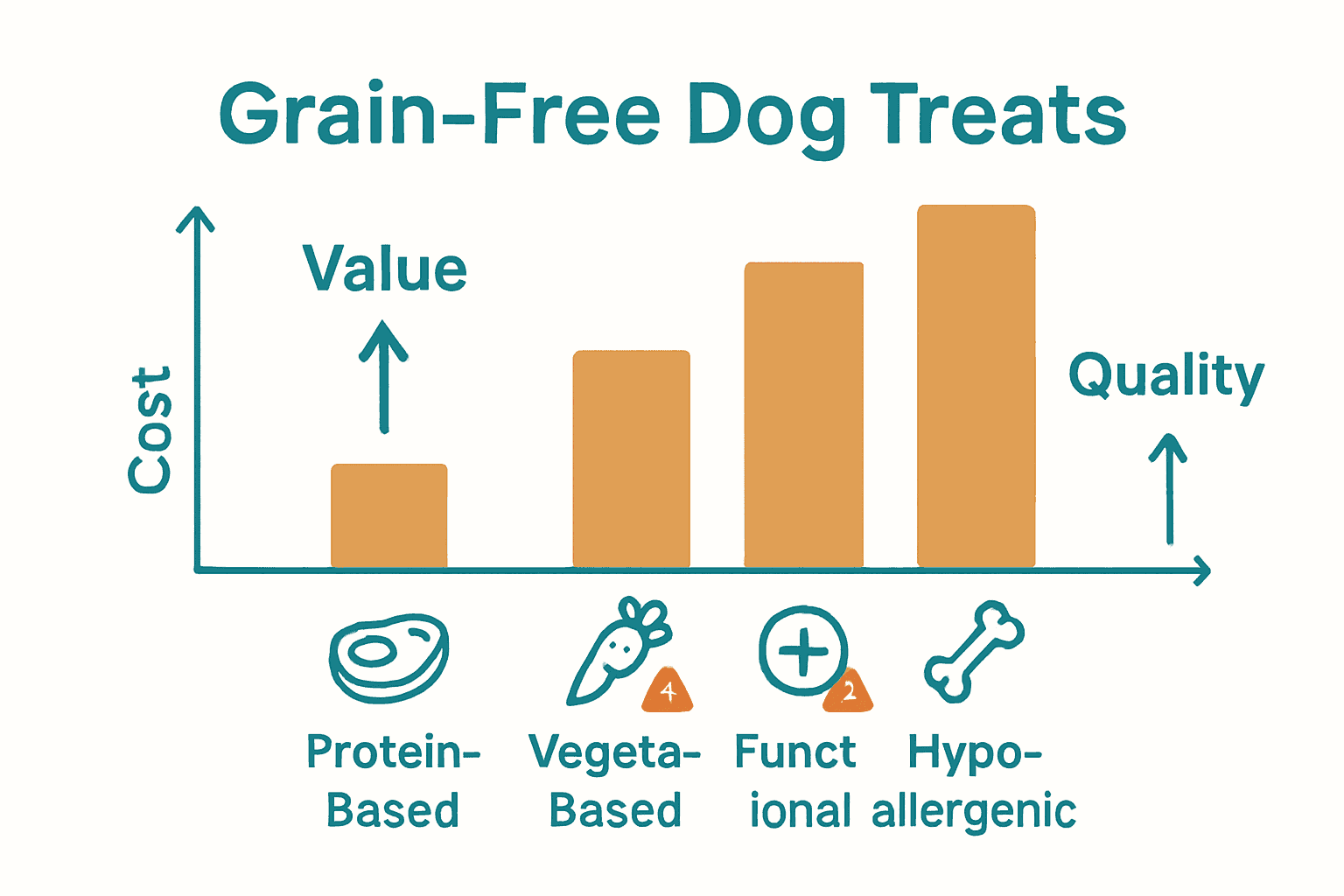Grain Free Dog Treats: Complete Guide to Benefits

Share
Did you know that over 40 percent of dog owners consider grain free treats for their pets? Many hope to avoid common allergens and support better digestion, yet the debate over their true benefits continues among experts. Choosing the right dog treats can influence your dog’s overall health and wellbeing. Understanding both the advantages and concerns around grain free options helps you make choices that support your pup’s unique needs.
Table of Contents
- What Are Grain Free Dog Treats?
- Types And Health Benefits Explained
- Natural Ingredients And Veterinary Formulas
- Choosing The Best Treat For Your Dog
- Cost, Quality, And What To Avoid
Key Takeaways
| Point | Details |
|---|---|
| Grain Free Definition | Grain free dog treats exclude traditional grains and use alternative ingredients designed to mimic a canine’s ancestral diet. |
| Nutritional Concerns | Veterinary nutritionists highlight that grains can offer dietary benefits, emphasizing the importance of nutritional complexity over ingredient elimination. |
| Types of Treats | Grain free treats are categorized into protein-based, vegetable-based, functional, and hypoallergenic, each addressing specific health considerations. |
| Choosing Wisely | Pet owners should assess their dog’s unique needs and consult veterinarians, focusing on ingredient quality and avoiding artificial additives when selecting treats. |
What Are Grain Free Dog Treats?
Grain free dog treats are specially formulated nutrition products designed without traditional cereal grains like wheat, corn, or barley. According to Sense About Science, these treats are often marketed as ‘natural’ or ‘vet-approved’, though the actual health benefits remain a topic of ongoing discussion among nutrition experts.
The core philosophy behind grain free dog treats stems from an attempt to mimic a canine’s ancestral diet, which historically contained minimal grains. As Which.co.uk explains, these treats replace traditional grains with alternative carbohydrate sources such as:
- Sweet potatoes
- Legumes
- Peas
- Tapioca
- Quinoa
While grain free treats might seem like a nutritional breakthrough, veterinary nutritionists caution that grains can actually provide important dietary benefits. Nutritional complexity matters more than simply eliminating an ingredient. These treats are typically crafted to address specific dietary needs, such as:

- Supporting dogs with specific grain sensitivities
- Providing alternative energy sources
- Potentially reducing inflammatory responses
Our understanding the benefits of grain free diet article offers deeper insights into this nuanced nutritional approach for your canine companion.
Types and Health Benefits Explained
Grain free dog treats come in several distinct varieties, each designed to address specific nutritional needs and health considerations. According to BSAVALibrary, veterinary professionals emphasise that while these treats are popular, there is currently no definitive scientific evidence supporting broad health benefits across all dogs.
The primary types of grain free dog treats include:
Here’s a summary of the main types of grain free dog treats and their potential benefits:
| Treat Type | Main Ingredients | Key Benefits |
|---|---|---|
| Protein-based | Chicken Beef Fish |
High protein Supports muscle development |
| Vegetable-based | Sweet potato Pumpkin Legumes |
Digestible Rich in fibre |
| Functional | Botanicals Omega oils |
Targeted health support Joint/skin care |
| Hypoallergenic | Limited novel proteins Excludes common allergens |
Reduces reactions Good for sensitivities |
-
Protein-based treats: Made with meat proteins like chicken, beef, or fish
-
Vegetable-based treats: Using ingredients like sweet potato, pumpkin, and legumes
-
Functional treats: Targeting specific health concerns such as joint health, skin condition, or dental care
-
Hypoallergenic treats: Designed for dogs with specific food sensitivities
As VectorOnto highlights, grain free diets may potentially lack essential nutrients typically found in traditional grain-containing foods. This means dog owners must be strategic in selecting treats that provide comprehensive nutritional support.
The health benefits of grain free treats can vary depending on individual dog needs. Potential advantages might include:
- Reduced digestive inflammation
- Better management of food sensitivities
- Potentially improved skin and coat health
- Alternative nutrient sources for dogs with specific dietary requirements
For a more comprehensive understanding of canine nutrition, explore our guide on understanding holistic dog nutrition, which provides deeper insights into creating balanced dietary approaches for your furry companion.
Natural Ingredients and Veterinary Formulas
Natural dog treats represent a sophisticated approach to canine nutrition, focusing on high-quality, minimally processed ingredients. As Sense About Science cautions, pet owners must carefully scrutinize labels, as terms like ‘natural’ are not always strictly regulated.
Key characteristics of veterinarian-formulated natural grain free dog treats typically include:
- Premium protein sources: Human-grade meats like chicken, lamb, or fish
- Minimal processing: Gentle cooking methods to preserve nutritional integrity
- Whole food ingredients: Incorporating vegetables, fruits, and botanical extracts
- No artificial preservatives: Using natural preservation techniques
Veterinary nutritionists emphasize that truly natural treats should provide comprehensive nutritional benefits beyond simple ingredient substitution. This means considering:
- Balanced macronutrient profiles
- Digestibility of ingredients
- Specific health support mechanisms
- Potential allergen considerations
To gain deeper insights into selecting optimal nutrition for your dog, explore our guide on understanding natural dog food ingredients, which offers comprehensive advice on making informed dietary choices for your canine companion.
Choosing the Best Treat for Your Dog
Selecting the ideal grain free dog treats requires careful consideration of your dog’s unique nutritional needs and health profile. According to Which.co.uk, it’s crucial to consult with a veterinarian and recognize that grain-free options are not inherently superior to other treats.
Key factors to consider when choosing treats include:
- Age and life stage: Puppies, adults, and senior dogs have different nutritional requirements
- Breed-specific needs: Some breeds have unique dietary sensitivities
- Health conditions: Dogs with allergies, weight issues, or specific medical concerns need tailored nutrition
- Activity level: More active dogs require different nutrient profiles
As Sense About Science emphasizes, understanding ingredient labels is critical. Don’t be swayed by marketing terms; instead, focus on:
- Protein quality and source
- Absence of artificial preservatives
- Balanced nutritional content
- Minimal processing
For dog owners seeking specialized nutrition, our 7 best hypoallergenic dog treats guide offers comprehensive insights into selecting treats for dogs with sensitive dietary needs.
Cost, Quality, and What To Avoid
Grain free dog treats represent a significant investment in your pet’s nutrition, with pricing often reflecting the quality of ingredients and production methods. According to Which.co.uk, these treats are frequently more expensive without guaranteed additional health benefits, making it crucial to evaluate cost-effectiveness carefully.
Critical factors influencing treat quality and cost include:
- Ingredient sourcing: Premium, human-grade ingredients typically increase price
- Processing methods: Minimal processing and gentle cooking techniques add value
- Protein concentration: Higher protein content often correlates with higher costs
- Brand reputation: Established brands with veterinary credentials may charge premium prices
As Sense About Science warns, dog owners should be wary of misleading marketing terms. Ingredients to definitively avoid in dog treats include:

- Artificial preservatives
- Artificial colors and flavors
- Excessive sugar or salt content
- Unspecified meat by-products
- Chemical additives with no nutritional value
For budget-conscious pet owners seeking high-quality nutrition, our guide on understanding natural dog food ingredients provides comprehensive insights into making smart, cost-effective dietary choices for your canine companion.
Discover the Perfect Grain Free Treats for Your Dog’s Unique Needs
If you want to support your dog’s health with carefully crafted, grain free treats that truly go beyond marketing claims, it starts with choosing quality ingredients designed for real benefits. The article highlights concerns around grain sensitivities and the need for balanced nutrition rather than simply eliminating grains. Whether your dog is a growing pup, an active small breed, or a large breed companion, finding treats that provide the right protein, fibre, and functional nutrients can help reduce digestive inflammation and promote healthy skin and coat.

Explore our range of Small Breed Grain Free Dog Food | Freshly Prepared & Natural or support your younger dog’s development by trying our Grain Free Puppy Food - Optimal Health & Nutrition. For larger breeds, we also offer tailored options in the Grain Free Large Breed ALL collection. Visit Ultimate Pet Foods today to find natural, vet-inspired nutrition solutions you can trust. Give your dog the treat they deserve with real nourishment backed by science and quality you will notice right away.
Frequently Asked Questions
What are grain free dog treats?
Grain free dog treats are specially formulated products that do not include traditional cereal grains such as wheat, corn, or barley. They often contain alternative carbohydrate sources like sweet potatoes, peas, and legumes.
What are the potential benefits of grain free dog treats?
Grain free dog treats may provide benefits such as reduced digestive inflammation, better management of food sensitivities, improved skin and coat health, and alternative nutrient sources for dogs with specific dietary needs.
How should I choose the best grain free dog treats for my dog?
When selecting grain free dog treats, consider your dog’s age, breed-specific needs, health conditions, and activity level. Additionally, pay attention to the quality of ingredients, protein sources, and the absence of artificial preservatives.
Are all grain free dog treats created equal when it comes to nutrition?
No, not all grain free dog treats are nutritionally equal. It’s important to evaluate treats based on their ingredients, protein quality, and overall nutritional content rather than simply focusing on the absence of grains.
Recommended
- Easy Dog Treat Recipes for Healthy, Grain-Free Snacks – Ultimate Pet Foods
- Understanding the Benefits of Grain Free Diet for Dogs – Ultimate Pet Foods
- Understanding Can Dogs Eat Grains: Nutrition Explained – Ultimate Pet Foods
- What Ingredients to Avoid in Dog Food for Healthier Pups – Ultimate Pet Foods





